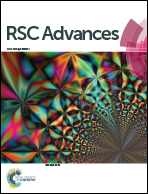Enhancing the conversion of ethyl levulinate to γ-valerolactone over Ru/UiO-66 by introducing sulfonic groups into the framework†
Abstract
The conversion of ethyl levulinate (EL) to γ-valerolactone (GVL) is an important reaction in biomass conversion. This process undergoes two consecutive reactions: hydrogenation and transesterification of the intermediate compound, i.e. ethyl 4-hydroxypentanoate, which are catalyzed by metal nanoparticles and acid sites, respectively. In this study, we explored the catalytic activity of Ru supported on metal organic frameworks aiming to develop efficient metal–acid bifunctional catalysts for this green process. UiO-66 and its analogues with various substituted groups (–SO3H, –NH2 and –NO2) were employed in this study. The Ru particle size, oxidation state and reducibility were characterized by TEM, H2-TPR, and XPS. The results suggest that the introduction of functional groups reduces the hydrogenation activity of pristine Ru/UiO-66 to various extents. Catalyst modified with –SO3H group shows much higher acidic catalytic performance while showing hydrogenation activity towards C![[double bond, length as m-dash]](https://www.rsc.org/images/entities/char_e001.gif) O bonds, thus improving the overall transformation of EL to GVL due to the presence of strong Brønsted acid sites.
O bonds, thus improving the overall transformation of EL to GVL due to the presence of strong Brønsted acid sites.



 Please wait while we load your content...
Please wait while we load your content...